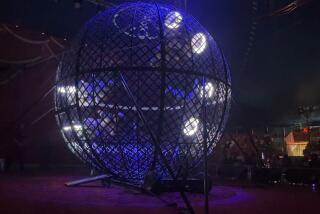Tradition of the Azores takes root in Central Valley bullrings
Reporting from Stevinson, Calif. — Ask any forcado why he stands unarmed in front of a charging bull and he’ll tell you he’s crazy.
Anyone watching would have to agree.
The Portuguese-style bullfighters don’t use spears or swords. They rely instead on brotherhood and synchronized steps. They don’t try to kill the 1,100-pound animal. They jump on its head, pull its tail and spin it into a dizzy stupor.
The forcados make their stand in festa bravas (bullfights) in the dusty dairy towns of Central California, places like Stevinson, Gustine and Laton, where the Azores islanders live.
For decades, the main export of the Azores — nine volcano tips in the Atlantic Ocean, 900 miles off the coast of Portugal — was its people. From 1941 to 1981, nearly 40,000 people from the bullfight-loving island of Terceira migrated to the Central Valley. Today there are more people of Azorean descent in California than there are in the islands. About 95% of the state’s 500,000 Portuguese are Azorean.
In summer, their communities come alive with the kind of festas that have been held in the Azores for centuries, with parades, a Catholic Mass and a bullfight.
::
On a Monday night in Stevinson (population 200), there are 3,000 people in a bullfight arena across the street from the Pentecost Assn. hall, almost all of them Portuguese Americans. They are waiting for the trumpets to announce the entrance of the bull.
Below the stands, in a narrow, circular passageway separated from the bull ring by a 4-1/2 -foot barrier, the forcados pace nervously.
They wear a uniform of skintight breeches, lacy white knee socks, red cummerbund, cropped brocade jacket, white shirt and red tie. Topping it off is a long, woolen, red and green hat that is all Christmas elf.
Jason McDonald, a 30-year-old service manager for General Motors in Modesto, makes the sign of the cross and waves to his two young sons in the stands.
Howard Drew, 40, taps the top of his socks; his secret trick is to wrap electrical tape around them to hold them up.
Drew, a former Marine, is older than most forcados and his heritage is not Portuguese, but German, Swedish and Native American. He was in the last vehicle to leave Kuwait after Operation Desert Storm in 1991.
“Once you’ve had bullets flying all around you — I don’t know if I was bored or what. I had a lot of friends who were Portuguese so I started bullfighting,” he said. “I’ve considered stopping, but I’m afraid if I quit I’ll get old.”
A forcado knows he’s been chosen to fight when he gets a tap on the shoulder from his coach.
The forcados work in teams of eight. In the ring, they line up single-file behind their frontman, called the caras. The caras walks ahead to “call” the bull, making eye contact, yelling “Touro! Touro!,” stamping his foot if that’s what it takes. When the bull charges, the caras backpedals. If all goes well, the bull, its horns wrapped in leather, will hit him smack in the gut, then plow through the rest of the line, piling up forcados like meringue ripples.
As the bull slows to a stop under a mound of bullfighters, one of them, the rabejador, grabs the tail, and the bull chases him in circles while the crowd roars.
In the Stevinson arena, the trumpets sound. The loud murmur of Portuguese falls silent. The bull enters the ring, dripping saliva. Several forcados, still behind their barrier, drop to their knees and pray.
Michael Lopes, 22, a rising forcado star who recently graduated from St. Mary’s College near Oakland with a degree in accounting, stays upright and stares straight at the bull.
Then Paulo Ferreira rides into the ring. He is the cavaleiro, a bullfighter on horseback.
He plays “pin the dart on the bull.” He and his horse spin away from the bull’s horns with balletic grace as he lands his beribboned darts.
In Portugal, they would be javelins stabbed into the bull’s neck. In the California version, called bloodless bullfighting, the darts are Velcro-tipped and are thrust into a pad glued to the bull’s shoulders.
George Martins, 48, coach of the Amadores de Turlock team, studies the thick-necked bull. Which of his forcados could best face this particular animal?
Martins walks over to Lopes. Neither looks at the other. They both watch the bull.
“Michael, this is your bull,” Martins says, touching Lopes’ shoulder.
Until this moment, Lopes, an affable young man with auburn curls, had an easy grin.
Now his face flushes and sets hard. He begins jumping up and down, fueled by adrenaline. He pounds his chest and arms with his fists. He pounds the wall with his head. He snorts.
Ferreira leaves the ring to cheers and women blowing kisses.
The eight forcados who have been chosen to fight place their hands on the barrier separating them from the bull.
To a man, the forcados say the scariest moment is never in the ring, but this one, just before entering.
Lopes holds up one finger, then two. When he raises a third and shouts “Showtime baby!” they leap over the wall in unison.
::
A bull will be in the ring only once in his life. They are smart animals and learn quickly to ignore the pink and yellow capes the bregas use to distract them when a bullfighter is in danger. Given a second chance in the ring, a bull would surely gore someone.
A bull that charges hard during his one appearance is considered a “noble” bull. He’ll probably be put to pasture to sire more of this breed called toura brava, or brave bull, which is raised only for fighting.
“It’s best for the bull if he is noble,” said Leonard King, 49, the first California-born forcado. “If he won’t fight, he’s going to be bologna.”
The cavaleiros are still largely imported from Portugal. But the forcados are born and bred in California’s dairy country, beginning with King in the late 1970s.
“They were trying to keep the traditions going, so they’d bring these guys over from Portugal. At first I thought, ‘These guys are nuts. Why would you stand in front of a bull?’ ” King recalled. “Then one day I said, ‘Dude, I want to do this.’ ”
When California banned bullfighting in 1957, an exception was made for Portuguese bullfights as long as they were connected to religious festas. Animal-rights advocates say that the events are dangerous celebrations of violence and that it is wrong to taunt an animal for entertainment, even with Velcro.
Forcado Donald Mota, 32, a San Francisco art school graduate, said the criticism should not be dismissed lightly.
“I get bothered when people use the word ‘tradition’ as the sole reason for bullfighting,” he said. “It’s got to be more than that. It should be to preserve something, to connect with culture, but also to remember and connect with your inner animal.”
When his father was dying of lung cancer, Mota found escape in being a forcado. He would hear his heart pound in his ears and feel a rush with each breath.
It was his father who first took him to the bullfights, where he is now introduced by older Azoreans as Donald, “son of Mota.”
David Magina, 34, owner of a water treatment business in Turlock, whose grandfather was a forcado in the Azores, said that fighting bulls has revealed to him the “purity and zeal of being alive.”
“You jump in the arena and suddenly everything goes quiet. You hear nothing. The bull’s coming at you and it’s like your mind takes pictures: click, click, click. There’s a smell. You can smell the fear, the intensity.
“The first time you grab a bull and don’t let go, you connect to something that’s in your blood: the islands, your grandfather, his grandfather, life.”
Catching bulls is not a competitive sport with scoring, but on this night in Stevinson, there are two teams facing three bulls each.
Amadores de Turlock was formed 35 years ago. The newer team, Aposento de Turlock, splintered off from the Amadores five years ago after a quarrel.
The Aposento team is having trouble catching one of its bulls. They have missed him twice.
On the third charge, there is a sickening crunch of bones. Their forcado line is scattered. Bregas rush to distract the bull with their swirling pink capes. Forcados from both teams jump the wall to retrieve the injured man.
Over the years, the Amadores have broken toes, fingers, noses, legs and a clavicle. Martins once woke up in a hospital bed with a concussion so severe that he thought he had six children instead of three and his wife’s name was Mary instead of Dorothy.
::
The trumpets play. The last bull for the Amadores enters the ring.
Martins’ son, Georgie, 22, will be out front. The caras is the only one who wears his hat in the ring. It’s a signal: When the caras puts on his hat, he is ready to call the bull.
Martins is turning to start his walk toward the bull when the animal lowers his head to charge. The bregas leap into the ring with their capes, prepared to go to the rescue.
But Martins shouts “It’s on!” and yanks the hat down on his head. The bull runs nearly the length of the arena before hitting and lifting Martins, who grabs the horns. The bull crashes through the other men, finally coming to a stop just before the far wall.
There is stunned silence. Then the crowd erupts in cheers.
They throw Martins flowers and hand him a bottle of wine, from which he takes a swig. A glamorous young woman leans down from the stands.
“What did you think when I put on my hat?” he shouts up at her.
“ ‘Move!’ ” she said.
Marcum is a Times special correspondent.
More to Read
Sign up for Essential California
The most important California stories and recommendations in your inbox every morning.
You may occasionally receive promotional content from the Los Angeles Times.











